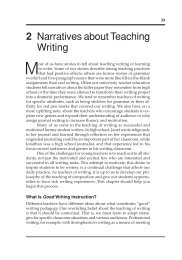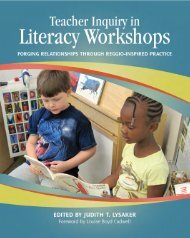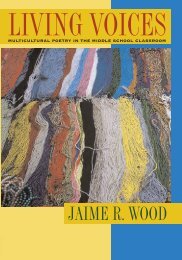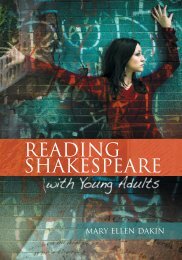Graphic novel Spread - National Council of Teachers of English
Graphic novel Spread - National Council of Teachers of English
Graphic novel Spread - National Council of Teachers of English
- No tags were found...
Create successful ePaper yourself
Turn your PDF publications into a flip-book with our unique Google optimized e-Paper software.
22 James Bucky Carter<br />
References<br />
Albers, P. (2006). Imagining the possibilities in multimodal curriculum<br />
design. <strong>English</strong> Education, 38, 75–101.<br />
Bitz, M. (2004). The comic book project: Forging alternative pathways to<br />
literacy. Journal <strong>of</strong> Adolescent & Adult Literacy, 47, 574–86.<br />
Bruggeman, L. (1997, January). “Zap! Whoosh! Kerplow!” Building highquality<br />
graphic <strong>novel</strong> collections with impact. School Library Journal,<br />
43(1), 22–27.<br />
Bucher, K. T., & Manning, M. L. (2004). Bringing graphic <strong>novel</strong>s into a<br />
school’s curriculum. Clearing House, 78, 67–72.<br />
Buckingham, D. (Ed.). (1998). Teaching popular culture: Beyond radical pedagogy.<br />
London: UCL Press.<br />
Cadiero-Kaplan, K. (2002). Literacy ideologies: Critically engaging the<br />
language arts curriculum. Language Arts, 79, 372–81.<br />
Callahan, B. (Ed.). (2004). The new Smithsonian book <strong>of</strong> comic-book stories.<br />
Washington, DC: Smithsonian Books.<br />
Carter, J. B. (2004). Textus/praxis. http://nmc.itc.virginia.edu/E-folio/1/<br />
EDIS542/2004Fall-1/cs/UserItems/jbc9f_555.html<br />
Cary, S. (2004). Going graphic: Comics at work in the multilingual classroom.<br />
Portsmouth, NH: Heinemann.<br />
CBS. (2005). Newest teaching tool: Comic books. Retrieved March 25, 2005,<br />
from http://www.cbsnews.com<br />
Cohn, N. Emaki productions. Retrieved October 13, 2003, from http://<br />
www.emaki.com<br />
Deasy, R. (Ed.). (2002). Critical links: Learning in the arts and student academic<br />
and social development. Washington, DC: Arts Education Partnership.<br />
Deasy, R. (Ed.). (2004). The arts and education: New opportunities for research.<br />
Washington, DC: Arts Education Partnership.<br />
DeCandido, K. R. A. (1990, March 15). Picture this: <strong>Graphic</strong> <strong>novel</strong>s in libraries.<br />
Library Journal, 115(5), 50–55.<br />
Dewey, J. (1916). Democracy and education:.An introduction to the philosophy<br />
<strong>of</strong> education (pp. 8–9). New York: Macmillan.<br />
Dorrell, L., & Carrol, E. (1981). Spider-man at the library. School Library<br />
Journal, 27(10), 17–19.<br />
Dyson, A. H. (1997). Writing superheroes: Contemporary childhood, popular<br />
culture, and classroom literacy. New York: <strong>Teachers</strong> College Press.<br />
Eisner, E. W. (1998). What do the arts teach RSA Journal No. 5485 2(4).<br />
London: RSA.<br />
Farrell, E. (1966). Listen, my children, and you shall read . . . <strong>English</strong> Journal,<br />
55(1), 39–45.
















